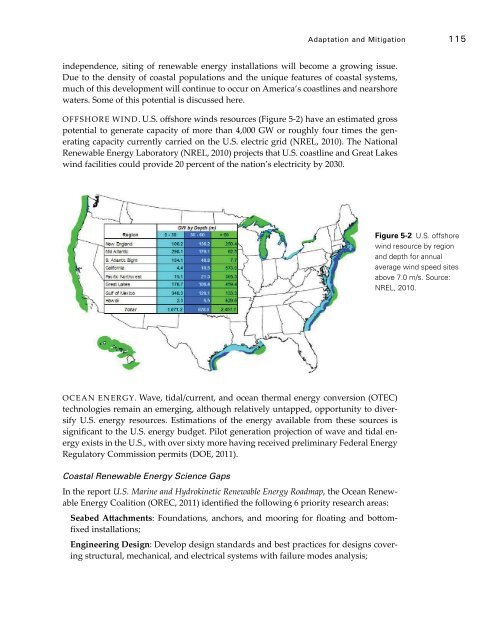- Page 1:
National Climate Assessment Regiona
- Page 5 and 6:
© 2012 The National Oceanic and At
- Page 8:
Coastal Impacts, Adaptation,and Vul
- Page 11 and 12:
Chapter 3Lead Author: Carlton H. He
- Page 16 and 17:
ContentsKey TermsAcronymsCommunicat
- Page 18 and 19:
4.4 Human Health Impacts and Implic
- Page 20 and 21:
Key TermsxixExposure 3 - The nature
- Page 22 and 23:
AcronymsxxiNAO - North Atlantic Osc
- Page 26 and 27:
Executive Summaryxxvffffffffffffffo
- Page 28 and 29:
Executive Summaryxxviiweakened by v
- Page 30 and 31:
Executive SummaryxxixAdaptation and
- Page 34:
Introduction and Context 3irrigatio
- Page 40 and 41:
Introduction and Context 9coastal w
- Page 42 and 43:
Physical Climate Forces 11fffffffff
- Page 44 and 45:
Physical Climate Forces 13Figure 2-
- Page 46 and 47:
Physical Climate Forces 15Sea-level
- Page 48 and 49:
Physical Climate Forces 17maintain
- Page 50 and 51:
Physical Climate Forces 19These low
- Page 52 and 53:
Physical Climate Forces 21Figure 2-
- Page 54 and 55:
Physical Climate Forces 23that surv
- Page 56 and 57:
Physical Climate Forces 25Table 2-2
- Page 58 and 59:
Physical Climate Forces 27Most of t
- Page 60 and 61:
Physical Climate Forces 29(low to m
- Page 62 and 63:
Physical Climate Forces 31A number
- Page 64 and 65:
Physical Climate Forces 33off the c
- Page 66 and 67:
Physical Climate Forces 35in these
- Page 68 and 69:
Physical Climate Forces 37this diff
- Page 70 and 71:
Physical Climate Forces 39in input
- Page 72 and 73:
Physical Climate Forces 41Intensifi
- Page 74 and 75:
Physical Climate Forces 43depth qua
- Page 76 and 77:
Physical Climate Forces 45precipita
- Page 78 and 79:
Physical Climate Forces 47Sea and w
- Page 80 and 81:
Physical Climate Forces 49by sea ic
- Page 82 and 83:
Physical Climate Forces 51niche ero
- Page 84 and 85:
Vulnerability and Impacts on Natura
- Page 86 and 87:
Vulnerability and Impacts on Natura
- Page 88 and 89:
Vulnerability and Impacts on Natura
- Page 90 and 91:
Vulnerability and Impacts on Natura
- Page 92 and 93:
Vulnerability and Impacts on Natura
- Page 94 and 95:
Vulnerability and Impacts on Natura
- Page 96 and 97: Vulnerability and Impacts on Natura
- Page 98 and 99: Vulnerability and Impacts on Human
- Page 100 and 101: Vulnerability and Impacts on Human
- Page 103 and 104: 72 Coastal Impacts, Adaptation, and
- Page 105 and 106: 74 Coastal Impacts, Adaptation, and
- Page 107 and 108: 76 Coastal Impacts, Adaptation, and
- Page 109 and 110: 78 Coastal Impacts, Adaptation, and
- Page 111 and 112: 80 Coastal Impacts, Adaptation, and
- Page 113 and 114: 82 Coastal Impacts, Adaptation, and
- Page 115 and 116: 84 Coastal Impacts, Adaptation, and
- Page 117 and 118: 86 Coastal Impacts, Adaptation, and
- Page 119 and 120: 88 Coastal Impacts, Adaptation, and
- Page 121 and 122: 90 Coastal Impacts, Adaptation, and
- Page 123 and 124: 92 Coastal Impacts, Adaptation, and
- Page 125 and 126: 94 Coastal Impacts, Adaptation, and
- Page 127 and 128: 96 Coastal Impacts, Adaptation, and
- Page 129 and 130: Chapter 5Adaptation and MitigationK
- Page 131 and 132: 100 Coastal Impacts, Adaptation, an
- Page 133 and 134: 102 Coastal Impacts, Adaptation, an
- Page 135 and 136: 104 Coastal Impacts, Adaptation, an
- Page 137 and 138: 106 Coastal Impacts, Adaptation, an
- Page 139 and 140: 108 Coastal Impacts, Adaptation, an
- Page 141 and 142: 110 Coastal Impacts, Adaptation, an
- Page 143 and 144: 112 Coastal Impacts, Adaptation, an
- Page 145: 114 Coastal Impacts, Adaptation, an
- Page 149 and 150: 118 Coastal Impacts, Adaptation, an
- Page 151 and 152: 120 Coastal Impacts, Adaptation, an
- Page 153 and 154: 122 Coastal Impacts, Adaptation, an
- Page 155 and 156: 124 Coastal Impacts, Adaptation, an
- Page 157 and 158: 126 Coastal Impacts, Adaptation, an
- Page 159 and 160: 128 Coastal Impacts, Adaptation, an
- Page 161 and 162: 130 Coastal Impacts, Adaptation, an
- Page 163 and 164: 132 Coastal Impacts, Adaptation, an
- Page 165 and 166: 134 Coastal Impacts, Adaptation, an
- Page 167 and 168: 136 Coastal Impacts, Adaptation, an
- Page 169 and 170: 138 Coastal Impacts, Adaptation, an
- Page 171 and 172: 140 Coastal Impacts, Adaptation, an
- Page 173 and 174: 142 Coastal Impacts, Adaptation, an
- Page 175 and 176: ReferencesAbuodha, P. & Woodroffe,
- Page 177 and 178: 146 Coastal Impacts, Adaptation, an
- Page 179 and 180: 148 Coastal Impacts, Adaptation, an
- Page 181 and 182: 150 Coastal Impacts, Adaptation, an
- Page 183 and 184: 152 Coastal Impacts, Adaptation, an
- Page 185 and 186: 154 Coastal Impacts, Adaptation, an
- Page 187 and 188: 156 Coastal Impacts, Adaptation, an
- Page 189 and 190: 158 Coastal Impacts, Adaptation, an
- Page 191 and 192: 160 Coastal Impacts, Adaptation, an
- Page 193 and 194: 162 Coastal Impacts, Adaptation, an
- Page 195 and 196: 164 Coastal Impacts, Adaptation, an
- Page 197 and 198:
166 Coastal Impacts, Adaptation, an
- Page 199 and 200:
168 Coastal Impacts, Adaptation, an
- Page 201 and 202:
170 Coastal Impacts, Adaptation, an
- Page 203 and 204:
172 Coastal Impacts, Adaptation, an
- Page 205 and 206:
174 Coastal Impacts, Adaptation, an
- Page 207 and 208:
176 Coastal Impacts, Adaptation, an
- Page 209 and 210:
178 Coastal Impacts, Adaptation, an
- Page 211 and 212:
180 Coastal Impacts, Adaptation, an
- Page 213 and 214:
182 Coastal Impacts, Adaptation, an
- Page 215 and 216:
184 Coastal Impacts, Adaptation, an
- Page 217:
Coastal Impacts, Adaptation, and Vu
















